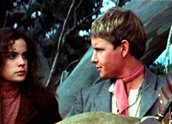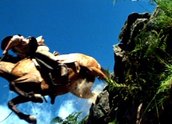


The Man from Snowy River (1982)
Synopsis
In the Australian Alps in 1880, a young stockman, Jim Craig (Tom Burlinson) must prove his worth when a valuable colt runs off to join a mob of brumbies. The colt’s rich owner, Harrison (Kirk Douglas), offers a reward, but Jim rides to clear his name and win a different prize – Harrison’s headstrong daughter Jessica (Sigrid Thornton).
Curator’s notes
The Man From Snowy River is an iconic Australian western, made to appeal to both the Australian and American markets. The casting of Kirk Douglas (in two roles) was part of that strategy, but the tailoring goes further, to the way the film is put together. It’s a naive film of epic proportions, but the naiveté is calculated to appeal to a sense of American nostalgia, and Australian chauvinism.
The film offered audiences a pristine landscape in which elemental melodrama could be played out, and George Miller’s direction leaves no cliché untried. The film has silhouetted riders against the sunset, a headstrong daughter and a pig-headed father, slow-motion images of rearing horses and riders cracking whips, and even a John Ford-style colourful character, in the one-legged gold miner Spur (Douglas’s second character), who’s always cooking wallaby stew.
The irony is that it’s a film about a poem that is barely known outside Australia – AB 'Banjo’ Paterson’s The Man From Snowy River. The poem celebrates a young man’s coming of age with a terrifying ride down an impossibly steep mountain. The film reproduces the story faithfully, but adds an entirely new layer of story and meaning. There are no women in the poem, but the film is full of them. Jim Craig loves Jessica (Sigrid Thornton) whose mother was the source of the bad blood between Harrison and his brother, Spur. Jessica is a young feminist, who demands respect from both her father and the man she loves – but the film is all about the limits of equality. As soon as Jessica runs off into the mountains, she gets into terrible trouble and must be rescued.
The film’s rampant symbolism would not have been out of place in an Australian film of the 1930s – the boy becomes the man by taming the wild horses and the wild woman, who swoons once she realises her own frailty. The American western, with similarly crude iconography, had all but disappeared from American screens in the 1980s. Perhaps that is one reason the film proved so popular: it offered unabashed nostalgia, with stunning landscapes and traditional, conservative social values. In Australia it became a huge hit, the biggest until Crocodile Dundee was released three years later.
- Overview
- Curator’s notes
- Video 3 clips

- Principal credits
- Find a copy
- Make a comment
- Map
- Add your review



